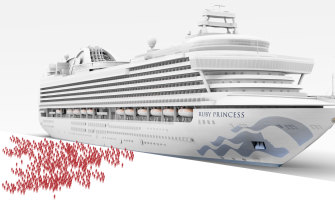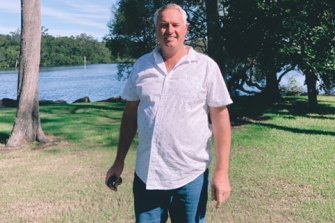Scars and redemption: the Ruby Princess legacy a year on
Western Australia Premier Mark McGowan could not resist a dig when he received a $7.3 million bill from NSW last week for putting WA residents up in hotel quarantine.
He posted on his Facebook page an image of the bill going through a paper shredder, adding: “We … never sent NSW a bill for the pain and hurt caused when the NSW Government let the virus go rampant off the Ruby Princess.” (Queensland’s Deputy Premier Steven Miles also posted on Facebook a video of himself shredding his state’s invoice from NSW.)
Yet Mr McGowan’s comment is evidence in itself that NSW did pay a price for the Ruby Princess.
One year after the cruise liner sailed through the Sydney Heads and spilled hundreds of coronavirus-infected passengers down its gangway — after border procedures were tightened, cruise ships were banned and hotel quarantine became mandatory for returning travellers — the episode continues to be raised as a symbol of ineptitude. The Ruby Princess framed the way that the pandemic was managed in ways that are still playing out.
“The main thing, I think, is that NSW has lifted its game completely,” said Lyn Gilbert, an infectious diseases physician who sits on government advisory panels.
“They took the criticism seriously and I think that contributed to the very good response subsequently to returning travellers, to contact tracing and so on. It was a good wake-up call.”
An artist’s impression of the Ruby Princess.Credit:Mark Stehle
The Ruby Princess outbreak infected more than 900 passengers and crew and spread to a further 62 people when those travellers returned to Australia. Twenty-eight people died. A special inquiry identified serious errors by public servants and the expert panel that advised the NSW government, which led to symptomatic passengers departing the cruise ship and continuing their travels.
Many of them have joined a class action filed by Shine Lawyers against Carnival Cruises, alleging that the cruise company failed to take appropriate measures to ensure their safety and prevent them from contracting coronavirus. They include Tony Londero, 63, who was taken off the ship by ambulance and continues to suffer health problems.
“It definitely left me affected,” Mr Londero said. “I’m so grateful to be alive, as well.”
Professor Gilbert said it was often overlooked that transmission was relatively limited once the passengers disembarked. But had the passengers been held on board, many more people would have been infected.
Tony Londero, one of two people with COVID-19 taken by ambulance from the Ruby Princess. The other patient died.
Adam Kamradt-Scott, an expert in the spread of infectious diseases who helped prepare Australia’s pandemic plan, said NSW became the best-performing state in Australia in terms of containing large outbreaks following the procedural changes it made after the Ruby Princess affair.
“The other element though, is that it really helped solidify a sense from the states and territories that they needed to take much greater control, particularly over entry into their jurisdictions,” Professor Kamradt-Scott said.
Within days of the Ruby Princess debacle becoming known, the Northern Territory, South Australia, Western Australia and Queensland closed their borders. Tasmania had already done so, on the day the ship docked.
Independent Tasmanian MP Madeleine Ogilvie was the first person to publicly speak in favour of state border closures, after she transited through Singapore during February 2020 and noticed how much effort was devoted to tracking and tracing.
“People thought I was over-dramatising but I just felt, having seen the Singapore reaction, that we needed to do something really quickly,” Ms Ogilvie said.
While the Ruby Princess did not precipitate the island state’s border closure, the images of people spilling off the boat confirmed local support for the policy, she said. “I think it’s in our psyche. We have a small and very connected population. We have a strong sense of community.”
UNSW researchers interviewed 40 people about their experience of the pandemic between May and July last year.
“At that point in the pandemic, people were very positive about border closures … and the Ruby Princess decisions were part of that,” said Deborah Lupton, a professor in health and social research.
“The Ruby Princess was something people were feeling upset and frightened about.”
Mr McGowan has repeatedly raised the Ruby Princess in response to calls for him to open the border. “NSW had the Ruby Princess – I mean seriously? And they are trying to give us advice on our borders, seriously?” he said in May last year. Earlier this month, he rejected a proposal by Qantas chief executive Alan Joyce for a co-ordinated approach to state borders, claiming his approach had worked.
But elsewhere, the spectre of the Ruby Princess is fading.
Ms Ogilvie said it was now time for the country “to come back together”.
Associate Professor Kamradt-Scott said it was no longer tenable for states to shut their borders in response to small outbreaks. “More than 12 months into the pandemic, we should have those systems in place so the contact tracers can do their job,” he said.
Mr Londero is contemplating a trip to Tasmania later this year to visit family, but was conscious that it would involve “going across on a boat”.
“Things are totally different to where they were a year ago,” Mr Londero said. “Something terrible can help you re-evaluate your life.”
Get our Coronavirus Update newsletter
Stay across the news you need to know related to the pandemic. Sent Monday and Thursday. Sign up here.
Most Viewed in National
From our partners
Source: Read Full Article



